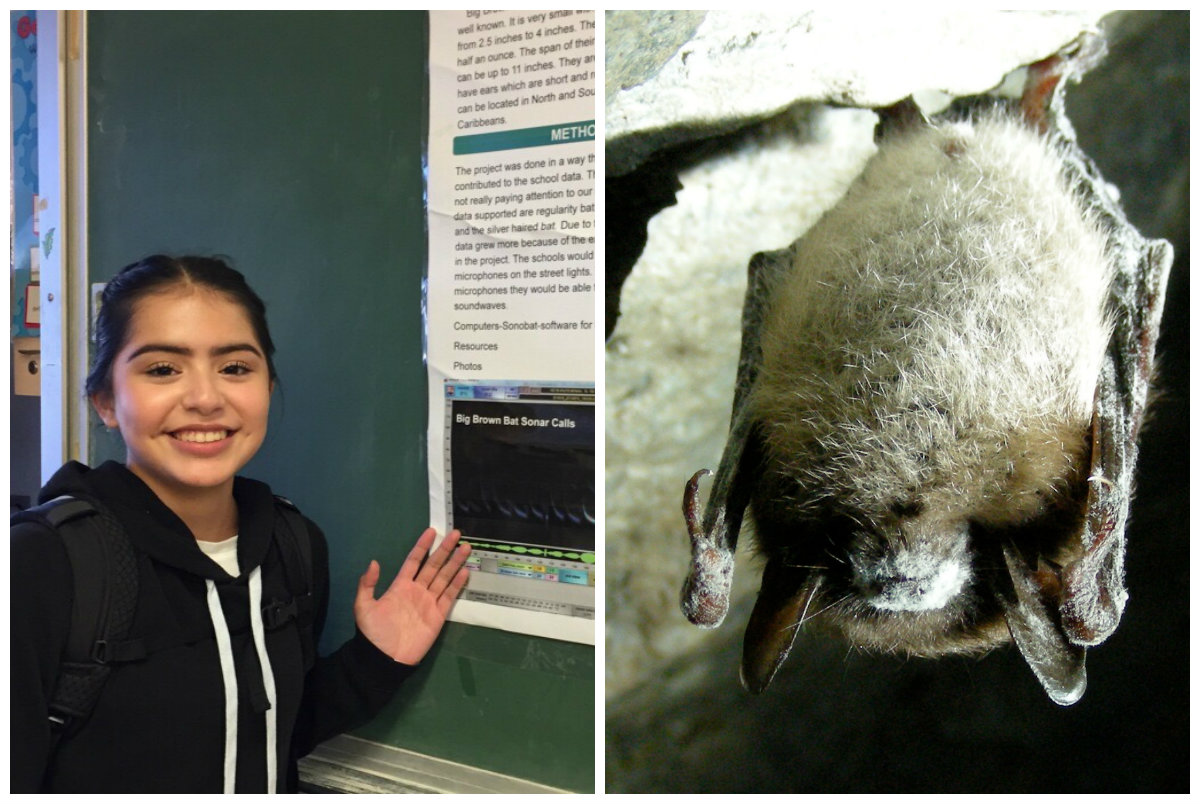Late October is about the only time people welcome the idea of bats in their homes—at least, ones made of rubber or paper.
Live bats hanging out near us the rest of the year? Well, that’s downright creepy to most.
But students at G.S. Hubbard High School in Jacqueline DiLorenzo’s earth science class were thrilled to learn their South Side public school had the most bat activity among the seven city schools monitoring the flying mammals during the 2016-2017 school year.
At first, the students seemed a bit hesitant, but then they became “excited and amazed by how many bat species that we had here,” DiLorenzo says, pointing to a poster that students made for their bat-monitoring project, in which they identified six species and 100 bat calls, about 10 times more than other schools.
The program is part of Lincoln Park Zoo’s Urban Wildlife Institute, which places special ultrasonic equipment on the roofs of participating schools. It reflects two growing nationwide trends: urban wildlife monitoring and the use of citizen scientists to collect and analyze the data. There is similar equipment in parks, golf courses, and forest preserves across the city and surrounding suburbs; hot bat call spots in Chicago have included McKinley Park and Caldwell Woods.
The institute also allows people to register their visual sightings by sending in reports to batsignal@lpzoo.org. Some have reported that “they see bats on their windowsills or buildings… as they are resting while they migrate,” says the institute’s assistant director Liza Watson Lehrer, adding that eight bat species either pass through and/or roost during the warmer months in the Chicago area.
Tracking U.S. bat species is of particular interest to biologists nationwide now because a fungal disease known as White Nose Syndrome has killed more than seven million bats, including whole colonies as they hibernate in caves. Some biologists have called it the “worst wildlife disease outbreak ever in North America.”
Since bats are a keystone part of our ecosystem (they pollinate and spread seeds as well as gobble up about 3,000 insects a night per bat, saving U.S. farmers about $23 billion annually), the federal government has spent about $40 million trying to combat the disease and dispel misconceptions about the animals through events such as National Bat Week, which is happening right now. Much like the alerts about declining bee population that began a few years ago, officials are now encouraging people to erect bat houses and plant bat gardens.
Bats have lived in cities for centuries, but counting the elusive creatures in urban environments—or anywhere, for that matter—is very challenging, says Jonathan Reichard of the U.S. Fish and Wildlife Service. Lincoln Park Zoo's acoustic data on bats and photos of other urban wildlife including coyotes, flying squirrels, beavers, and even mink, captured on its wildlife cameras, make up one of the world’s largest data sets of urban wildlife, Lehrer says. That data is now being shared with other cities with the goal to “build smarter, greener cities that can be part of the solution to the biodiversity crisis.”
In addition to the stationary monitors, biologists have trained squads of citizen scientists in both rural and urban areas to use portable bat detectors that can plug into a cellphone or iPad. The Will County Forest Preserves is taking applications for its roving bat detection squads, with hikes starting in spring 2018, and Lehrer says the zoo’s wildlife institute hopes to roll out a similar program as early as next summer.
Three Ways to Celebrate National Bat Week
Can't wait for the warm weather to enjoy some batty activity? Here are three ways to learn about these critters this weekend.
Bat Chats
Lincoln Park Zoo, 2001 N. Clark St.
Today through Sunday, stop by the Regenstein Small Mammal Reptile House during Lincoln Park Zoo’s Fall Fest to see live Egyptian fruit bats and hear "bat chats" at 11:45 a.m. daily. They'll debunk common myths and discuss why bats are more important than most people think.
Creatures of the Night
Garfield Park Conservatory, 300 N. Central Park Ave.
A live bat (along with owls, snakes, and a sloth) will be at the Creatures of the Night event on Saturday from noon to 3 p.m. Plus, there’s a string band, a Monster Mash Costume bash, and Flea Circus performances at 12:30 and 1:30 p.m.
Owls, Bats & Spiders
Crabtree Nature Center, 3 Stover Rd., Barrington Hills
Listen to bat calls, dissect an owl pellet, and meet a live owl at the Owls, Bats & Spiders event Sunday at 1 p.m. While you're there, ask about the center’s popular Night Bat Walks during the warmer months.




